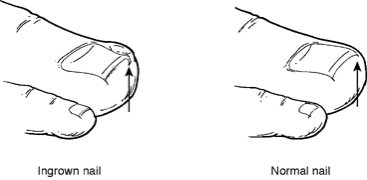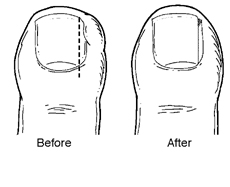Connect With Us
Ingrown Toenails
Ingrown Toenails Treatment in Overland Park, KS

Signs that may indicate the formation of an ingrown toenail include redness, pain, swelling of the surrounding skin, possible bleeding or oozing of pus, and an overgrowth of the skin around the nail. The surrounding skin may also feel tender and become swollen or hardened. Most ingrown toenails are diagnosed by a simple physical exam; however, an x-ray may be required to show how deep the nail has grown into the skin of the toe.
Many factors influence the likelihood of developing an ingrown toenail. The most common way ingrown toenails are formed is due to an incorrect method in how the toenails are trimmed. If you cut your toenails too short or cut them at an angle, you’re putting yourself at risk of getting this condition. Another main factor that contributes to ingrown toenails is the choice of footwear. Those who commonly wear tightly fitted shoes, such as high heels, that do not give the toes enough room, put too much pressure on the big toes. This can create an ingrown toenail. To alleviate the pain, a small piece of cotton may be fitted underneath the nail. However, in more serious cases, total removal of the nail may be necessary.
For a proper diagnosis and advised treatment plan, we recommend you seek the care of a podiatrist as soon as you notice the warning signs of an ingrown toenail.
What Is an Ingrown Toenail?
When a toenail is ingrown, it is curved and grows into the skin, usually at the nail borders (the sides of the nail). This digging in of the nail irritates the skin, often creating pain, redness, swelling and warmth in the toe.
If an ingrown nail causes a break in the skin, bacteria may enter and cause an infection in the area, which is often marked by drainage and a foul odor. However, even if the toe is not painful, red, swollen or warm, a nail that curves downward into the skin can progress to an infection.

Causes
Causes of ingrown toenails include:
- Heredity. In many people, the tendency for ingrown toenails is inherited.
- Trauma. Sometimes an ingrown toenail is the result of trauma, such as stubbing your toe, having an object fall on your toe or engaging in activities that involve repeated pressure on the toes, such as kicking or running.
- Improper trimming. The most common cause of ingrown toenails is cutting your nails too short. This encourages the skin next to the nail to fold over the nail.
- Improperly sized footwear. Ingrown toenails can result from wearing socks and shoes that are tight or short.
- Nail conditions. Ingrown toenails can be caused by nail problems, such as fungal infections or losing a nail due to trauma.
Treatment
Sometimes initial treatment for ingrown toenails can be safely performed at home. However, home treatment is strongly discouraged if an infection is suspected or for those who have medical conditions that put feet at high risk, such as diabetes, nerve damage in the foot or poor circulation.

Home Care
If you do not have an infection or any of the above medical conditions, you can soak your foot in room-temperature water (adding Epsom salt may be recommended by your doctor) and gently massage the side of the nail fold to help reduce the inflammation.
Avoid attempting “bathroom surgery.” Repeated cutting of the nail can cause the condition to worsen over time. If your symptoms fail to improve, it is time to see a foot and ankle surgeon.
Physician Care
After examining the toe, the foot and ankle surgeon will select the treatment best suited for you. If an infection is present, an oral antibiotic may be prescribed.
Sometimes a minor surgical procedure, often performed in the office, will ease the pain and remove the offending nail. After applying a local anesthetic, the doctor removes part of the nail’s side border. Some nails may become ingrown again, requiring removal of the nail root.
Following the nail procedure, a light bandage will be applied. Most people experience very little pain after surgery and may resume normal activity the next day. If your surgeon has prescribed an oral antibiotic, be sure to take all the medication, even if your symptoms have improved.
Preventing Ingrown Toenails
Many cases of ingrown toenails may be prevented by:
- Proper trimming. Cut toenails in a fairly straight line, and do not cut them too short. You should be able to get your fingernail under the sides and end of the nail.
- Well-fitting shoes and socks. Do not wear shoes that are short or tight in the toe area. Avoid shoes that are loose because they too cause pressure on the toes, especially when running or walking briskly.
What You Should Know About Home Treatment
- Do not cut a notch in the nail. Contrary to what some people believe, this does not reduce the tendency for the nail to curve downward.
- Do not repeatedly trim nail borders. Repeated trimming does not change the way the nail grows and can make the condition worse.
- Over-the-counter medications are ineffective. Topical medications may mask the pain, but they do not correct the underlying problem.
